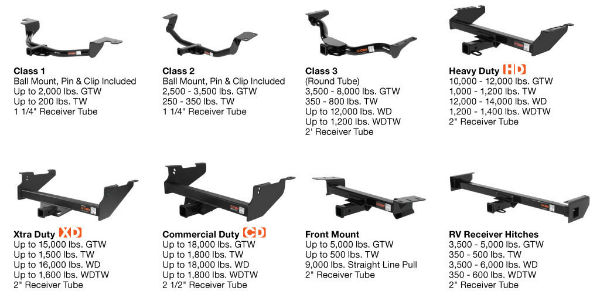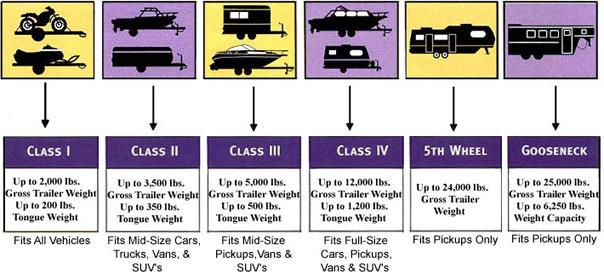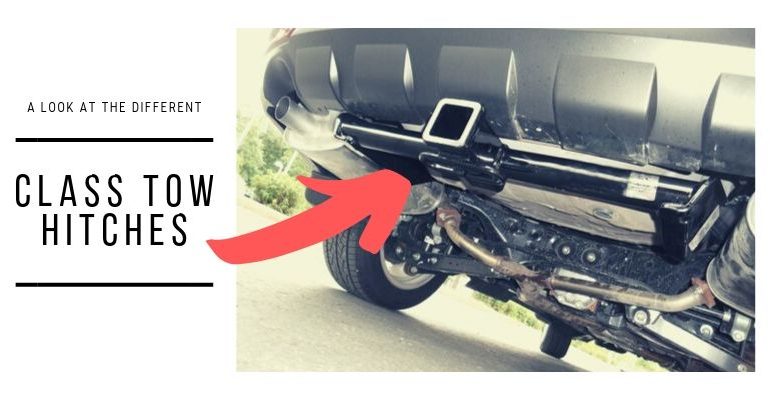There are five hitch classes that exist, and each of them will give you an idea of the weight limit you can pull using your towing gear. A trailer hitch is the extra piece of hardware you install on the frame or chassis of your vehicle, which allows you to link up a trailer to it.
There are various types of hitches you can use for towing a trailer, and it can be a complex decision for a first-time trailer owner to decide the best one for their trailer. Fortunately, the trailer hitch classes provide you a simple and easy-to-understand system that you can use to determine if your trailer hitch is up to the task.
What Are The Choices?
There are several types of trailer hitches you can choose from, and each of them has its own advantages and disadvantages. You can have your pick from receiver hitches, 5th wheel or gooseneck hitches. You can also have a weight distribution hitch, or go for a pintle hitch instead.
Some hitches are designed for heavy duty towing, while others are more suited for lighter loads. The trailer hitch class lets you immediately know if you have gotten yourself a hitch that can, with proper installation, support the trailer and cargo you are planning to transport.
The most common classes in use in North America and other areas are defined by the Society of Automotive Engineers or SAE, and these include the first four load classes at the moment – Class I, Class II, Class III, and Class IV. Towing gear and hitch manufacturers also often refer to a fifth class, Class V, although it’s a category that is currently not in the SAE J684 standard.

Commercial/Industrial Duty Classes:
Some manufacturers have also recently come out with hitches rated above the current Class V tow rating limit. You may see them rated at 30,000 pounds maximum or even more, and these hitches are as close you can get to industrial towing capacities – in many cases, you are only limited by how much weight your truck can pull.
The different trailer hitch classes can also be described by the load duty they are designed for. Class I and Class II hitches are made for light loads. Class III hitches, on the other hand, are designed for medium duty towing. Class IV and Class V trailer hitches are where you begin to get into heavy duty and commercial loads, provided that you have the appropriate vehicle for it.
Trailer hitch classes describe weight capacity – that is, they indicate the maximum weight of the trailer, as measured by the trailer’s gross trailer weight rating. The gross trailer weight rating is the weight of the trailer combined with the weight of passengers, cargo, fuel, fluids, and other necessities assuming that the trailer is loaded to capacity.
Trailer hitches that are designed to pull semi trailers and other loads that have to be partially supported by the hitch itself are called weight carrying trailer hitches, or WC trailer hitches. As such, part of the load has to be supported at the link point as well, and the amount of this load is described by the tongue weight.
That is why the different trailer hitch classes also have a tongue weight limit associated with each of them, as well. Most manufacturers recommended having a tongue weight within 10 to 15 percent of the gross trailer weight rating, and so you would see tongue weight recommendations around those values for your trailer hitch as well.

Class I Trailer Hitches
Class I hitches are generally rated for loads up to 2,000 pounds or 910 kilograms. They are also rated for a maximum tongue weight of 200 pounds as well, since Class I hitches are typically weight-carrying hitches. One of the most common examples of a Class I trailer hitch is a receiver tow bar with a 1-1/4 inch square receiver.
Trailer hitch gear designed for Class I loads are usually installed to the vehicle frame or the truck pan, and you will also find some of the light duty variants attached directly to the bumper.
Class I trailer hitches match well with compact passenger vehicles, and most hitches in this category are designed for use with compact cars, hatchbacks, compact utility vehicles, sedans and smaller SUVs.
You can pull light loads with a vehicle and hitch setup rated Class I, so you can expect to tow things like bike racks, tent campers, cargo carriers, mobility scooters drawbars and similar loads. You can also pull smaller trailers loaded with lighter water toys and equipment, including kayaks, canoes, and jet skis.
Class II Trailer Hitches
Class II trailer hitches are rated for up to 3,500 pounds gross trailer weight, or around 1,600 kilograms. You can expect a Class II setup to take on a maximum of 300 to 500 pounds trailer tongue weight, as well., depending on the type of hitch you use. Just like Class I hitches, Class II square receivers also measure 1-1/4 and 2 inches in size, depending on your kit.
Tow vehicles that can use a Class II trailer hitch include full size sedans and larger compacts, as well as larger CUVs. Minivans, SUVs, and smaller pickups can also use Class II hitches, although owners may also opt to go for larger Class III or Class IV hitches instead. Hitches in this class are usually attached to the vehicle frame or bumpers, so you can also consider them to be weight carrying hitches just like Class I gear.
Class II hitches are useful for light duty towing as well as some heavier loads. You can load a larger bike rack with more bikes, cargo carrier or mobility scooter with the higher weight capacity of a Class II trailer hitch. The extra capacity also lets you pull larger water equipment, including small boars, multiple jet skis and similar loads. At this weight range, you can now also transport small campers as well.
Class III Trailer Hitches
A Class III trailer hitch is when you can start getting into medium duty towing. Hitches in this class are designed for maximum gross trailer weight ratings of 5,000 to 8,000 pounds, depending on the type of trailer hitch you pick – as you can see, the capacity range for this class varies a bit.
You can expect Class III trailer hitches to be rated at around 500 to 1000 pounds tongue weight, as well. At this weight range, these hitches tend to come with 2 inch receivers, so if you are using a tow ball mount designed for 1 ¼ inch receivers, you will have to find one of those adapters designed to convert between these receiver sizes.
Class III trailer hitches are commonly designed to be installed to the vehicle frame, and given the wide range of vehicles you can attach a Class III hitch to, you may have to shop for a bit to make sure that you are getting a kit that matches your tow vehicle.
The typical tow vehicles for this class of trailer hitches include sedans, regular and minivans, regular and larger SUVs and most other types of larger passenger vehicles. Class III trailer hitches also tend to be the lightest hitches you can find for pickup trucks and heavy duty trucks, as well.
Class III hitch setups let you tow a much wider range of loads compared to light duty hitches. At this range, you can pull small and midsize campers in addition to the usual bike and cargo carriers. You can use utility trailers to pull small boats, kayaks, and canoes, as you would expect. At this range, you will also be able to pull trailers carrying multiple motorcycles, snowmobiles, and lawn maintenance equipment at this weight class, as well.
Since you have the capacity to pull larger trailers and longer flatbed trailers with a Class III trailer hitch, this is also the weight class where you begin to see weight distribution hitches and sway control features.
If you plan to tow a larger camper trailer, you may need to decide if you need a weight carrying setup, or if a weight distribution system is a better fit for you. Weight distribution systems can significantly improve the drivability and safety of your setup for a bit of additional cost and setup work.
Class IV Trailer Hitches
For heavy duty towing applications, you will definitely need the additional towing capacity that a Class IV trailer hitch provides. Class IV trailer hitches are typically rated for up to 10,000 pounds or 4,500 kilograms of maximum gross trailer weight.
You will also find hitches rated for up to 14,000 pounds classified under Class IV, as well, so it varies depending on the type of trailer hitch system you choose to install. You can expect to find weight distributing hitches recommended more often as you go up in gross trailer weight.
Generally, Class IV trailer hitch receivers will have 2 inch openings for attaching carriers and tow ball mounts.
Class IV hitches, just like other hitch classes designed for heavy duty towing, attach to the vehicle frame only – don’t expect to find bumper hooks in this class.
Class IV hitches and the towing systems that are designed to work with them are made for heavy duty work, so you can expect to pull large loads with them. That’s why weight distribution and sway control features are built into many Class IV hitches that you will find on the market.
Not all Class IV trailer hitches are weight distribution hitches, though, since there are still some that are designed to be weight carrying types. To determine which type of Class IV hitch system you need for your load, consider the type of trailer you will be pulling. Large campers, horse trailers, and utility semi trailers are typically better pulled with a weight distributing hitch, depending on the vehicle and the load you will be transporting.
You can carry pretty much any accessory made for a 2 inch receiver, like bike racks, cargo carriers, boats, and flatbed trailers. At this range, you can now also tow large campers, toy haulers, large passenger boars, horse, and livestock trailers. You can also pull commercial loads such as smaller haulers, dump trailers and containers assuming that your vehicle is up to the task.
Of course, you will need the proper tow vehicle to make use of the towing capacity that a Class IV trailer hitch provides. That is why you will usually see Class IV hitches made only for larger SUVs and heavy duty pickup trucks. Class IV hitches are also common for half-ton and full ton trucks as well.
Class V Trailer Hitches
Class V hitches are the highest general weight class available for most towing gear on the market. They are made for heavy duty towing, so you will find these hitches available only for large SUVs, vans, and heavy duty pickups and trucks.
Class V hitches use 2 ½ inch receivers in general, although you may also find kits using 2 inch receivers at the lower weight capacity ranges, or 3 inch receivers at the top end.
Class V trailer hitches are rated for a wide range of gross trailer weight capacities. Class V weight carrying hitches, the ones are not designed for weight distribution systems, are usually rated for up to 12,000 pounds gross trailer weight. Those that are designed for weight distribution systems are rated for up to 17,000 pounds or 7,700 kilograms of gross trailer weight. You will also see Class V trailer hitch receivers rated for up to 20,000 pounds as well.
To make the most out of a Class V trailer hitch, you should be using them for real heavy duty towing – pulling equipment haulers, multiple trailers, containers or large toy haulers. Class V trailer hitches are usually reserved for the most powerful of tow vehicles, including half-ton and heavy duty trucks to commercial trucks.
Custom Trailer Hitches
A few hitches can exceed the tow rating limit of a Class V trailer hitch, and you can find them rated at around 30,000 pounds with weight distribution. These systems are usually custom kits that use multiple receivers and are designed for the heaviest of hauling tasks.
